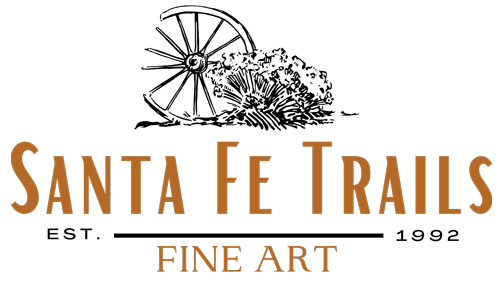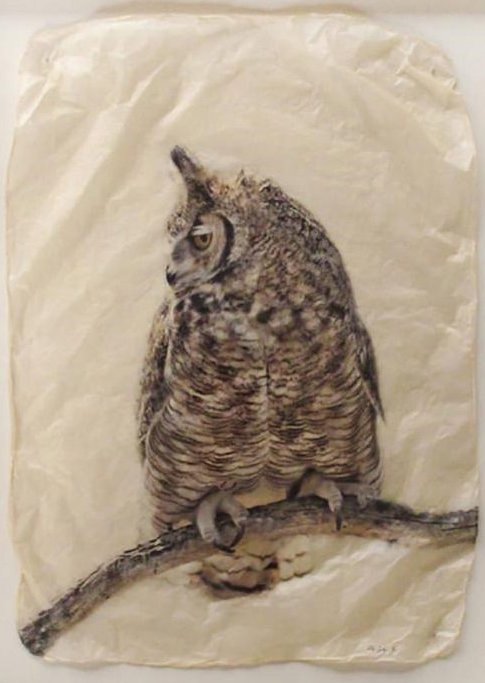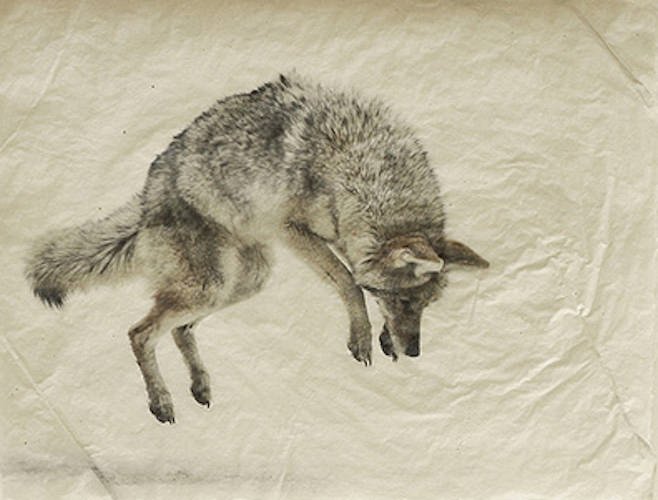Pete Zaluzec
-
These images are heavily processed photographs….removing some or all of the background and isolating the subject, and a lot of adjustments to lights and darks, white balance, contrast, clarity and etc. in order to print in on a non-white rice tissue paper which is the gampi. The images are printed on two separate sheets of the gampi rice tissue paper with the exact same image printed on both sheets. Then they are perfectly aligned over each other over a light box matching up every hair, blade of grass and details so that everything is registered. This is what gives it dimension and saturation that you could not get with a standard print. The rice tissue paper is translucent, so to some degree you are seeing thru one sheet into the other (an accidental discovery). The two sheets are fused together with a solution that glues them together and wrinkles the paper. I add to this effect by force drying it with a hair dryer and adding some creases to the paper. The edges are deckled by carefully tearing the perimeter of the paper while it is still wet with solution. The completed piece is fastened to the custom lacquered frame with small nails in the corners of the paper. It’s all archival, including special glass. The GAMPI sheets are made in Southwestern Japan in a 6th Generation Paper Mill. The “Papermaker” has no spouse or children and his sister who was helping now retired. The Chinese characters for GAMPI literally translates to “goose skin”, but the it may also be referred to as “silk tissue”. Either in its sheet form or in the raw fiber form, GAMPI by its natural make-up, reacts to ink as if it had sizing on it. In other words, it holds ink on its extremely well. For artist Pete Zaluzec, the ability to hold ink combined with its durability make GAMPI the perfect paper to produce his truly unique wildlife images. GAMPI fiber comes from the inner bark of branches of the gampi bush. Since it is difficult to cultivate, it is obtained from wild plants making it a highly coveted commodity. Historically, GAMPI was used for mimeographs. Today, with its high quality finish, the uses have expanded to chine colle, etching, lithograph, monotypes, ink jet printing, and model-making. It is extremely strong!
-
SOUTHEASTERN WILDLIFE EXPOSITION Charleston, SC
-
These images are heavily processed photographs, removing some or all of the background and isolating the subject. The artist then made adjustments to the lights and darks, white balance, contrast, clarity, etc., in order to print on a non-white rice tissue paper, called “GAMPI.”
The images are printed on two separate sheets of the GAMPI rice tissue paper, with the exact same image printed on both sheets. They are then perfectly aligned over each other, using a light box to line up every hair, blade of grass and detail, so that everything is perfectly registered. This is what gives them the dimension and saturation that isn’t seen on standard prints.
The rice tissue paper is translucent, so to some degree, you are seeing through one sheet into the other (an accidental discovery).
The two sheets are fused with a solution that glues them together and wrinkles the paper. The artist adds to this effect by force drying with a hair dryer, then adding some creases to the paper.
The edges are deckled by carefully tearing the perimeter of the paper while it is still wet with solution.
The completed piece is fastened to the custom-lacquered frame with small nails in the paper’s corners. It’s all archival, including the special glass used.
The GAMPI sheets are made in Southwestern Japan, in a 6th generation paper mill. The papermaker has no spouse or children, and his sister, who was helping him, has now retired.
GAMPI fiber comes from the inner bark of branches of the Gampi bush. Since it is difficult to cultivate, it is obtained from wild plants, making it a highly coveted commodity.
Historically, GAMPI was used for mimeographs. Today, with its high-quality finish, the uses have expanded to chine colle, etching, lithograph, monotypes, ink jet printing and model-making. It is extremely strong!
The Chinese characters for GAMPI literally translate to “goose skin,” but it may also be referred to as “silk tissue.” Either in its sheet form or in the raw fiber form, GAMPI, by its natural makeup, reacts to ink as if it had sizing on it. In other words, it holds ink extremely well. For artist Pete Zaluzec, the ability to hold ink combined with its durability make GAMPI the perfect paper to produce his truly unique wildlife images.
Artwork
*click on each image to see more info

























